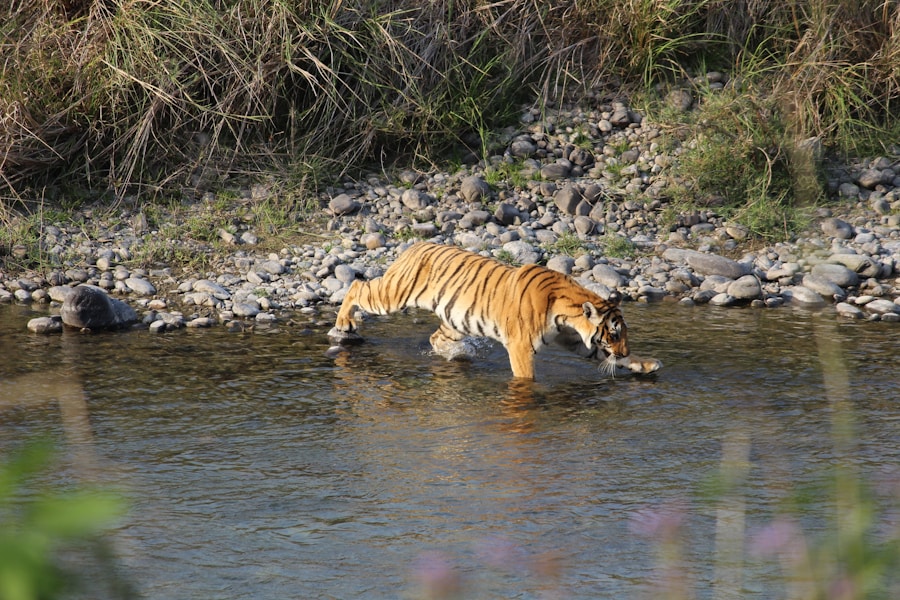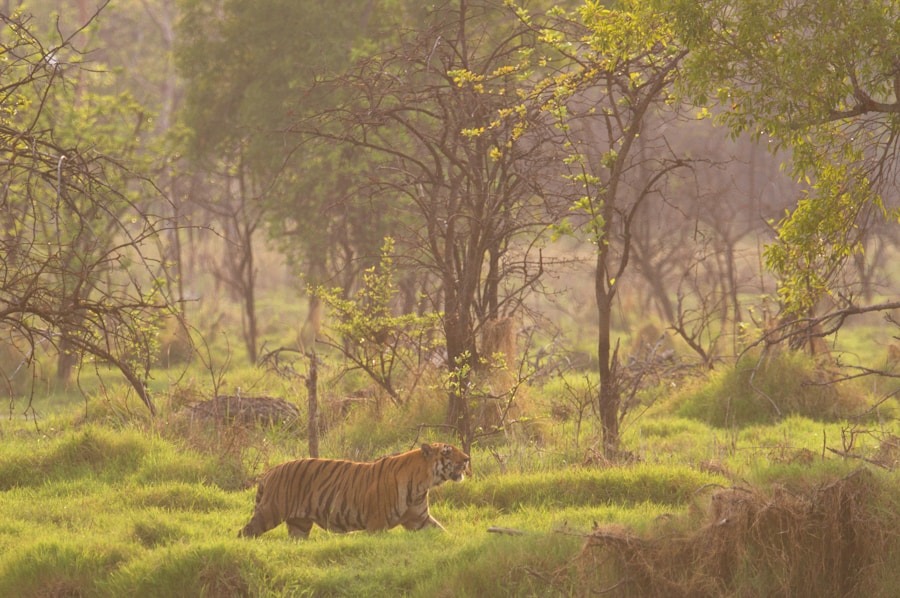Jim Corbett, a name synonymous with wildlife conservation and the thrilling tales of man versus beast, is perhaps best known for his encounters with some of the most formidable predators in the Indian subcontinent. Among these stories, the tale of Goongi, a notorious man-eating tiger, stands out as a poignant chapter in Corbett’s illustrious career. This particular tiger, whose name translates to “the mute one,” was not just a creature of the wild; it became a symbol of the complex relationship between humans and nature.
Corbett’s narrative surrounding Goongi is not merely a recounting of events but an exploration of the intricate dynamics of survival, fear, and respect for wildlife. The story of Goongi unfolds against the backdrop of the Kumaon region in India, where Corbett spent much of his life. This area, characterized by its dense forests and diverse fauna, provided the perfect setting for both the majestic and the menacing.
Corbett’s deep understanding of animal behavior and his profound respect for nature allowed him to navigate this world with a unique perspective. The tale of Goongi is not just about a tiger that turned to man-eating; it is also about the circumstances that led to such behavior and the broader implications for wildlife conservation. Through his experiences with Goongi, Corbett illuminated the delicate balance between human encroachment and wildlife habitats, a theme that resonates even today.
Key Takeaways
- Jim Corbett’s Goongi is a legendary man-eating tiger that terrorized the people of Kumaon in the early 20th century.
- The legend of the man-eating tiger has been immortalized in Jim Corbett’s writings and has become a symbol of the conflict between humans and wildlife.
- Jim Corbett’s approach to hunting the man-eating tiger was unique, as he relied on his tracking and stalking skills rather than using firearms.
- Goongi’s legacy extends beyond the terror it instilled, as it sparked a movement for conservation and wildlife protection in India.
- The impact of Goongi on wildlife literature is profound, as it inspired a new genre of writing that focuses on the relationship between humans and wildlife.
The Legend of the Man-Eating Tiger
The legend of Goongi is steeped in tragedy and intrigue. This particular tiger gained notoriety for its unusual behavior, which led to a series of fatal encounters with humans. The circumstances surrounding Goongi’s transformation from a majestic predator to a man-eater are complex and multifaceted.
It is widely believed that the tiger had suffered an injury that rendered it unable to hunt its natural prey effectively.
This shift in behavior highlights a critical aspect of wildlife dynamics: when natural prey becomes scarce or when an animal is injured, it may resort to desperate measures for survival.
Corbett’s accounts detail the fear that gripped local communities as they became aware of Goongi’s presence. The tiger’s reputation grew, and with it, the tension between humans and wildlife escalated. Villagers took precautions, altering their daily routines and avoiding areas where the tiger was known to roam.
Corbett himself was drawn into this narrative not only as a hunter but as a protector of both people and wildlife. His mission was not merely to eliminate a threat but to understand the underlying causes of Goongi’s behavior. This duality in Corbett’s approach—recognizing the need for human safety while advocating for wildlife preservation—sets the stage for a deeper exploration of his philosophy regarding nature.
The Silent Hunter: Jim Corbett’s Approach

Jim Corbett’s approach to hunting was marked by a profound respect for wildlife and an understanding of animal behavior that was ahead of his time. Unlike many hunters who sought trophies for sport, Corbett viewed his encounters with animals as opportunities for learning and connection. His methodical approach to tracking Goongi exemplified this philosophy.
He spent countless hours observing the tiger’s movements, understanding its habits, and piecing together the puzzle of its life in the wild. This meticulous attention to detail allowed him to anticipate Goongi’s actions and ultimately devise a plan to confront the threat it posed. Corbett’s respect for nature extended beyond mere observation; he believed in coexisting with wildlife rather than dominating it.
His writings reflect a deep empathy for animals, recognizing that they are driven by instinct and survival needs. In his pursuit of Goongi, he often reflected on the broader implications of human encroachment on natural habitats. He understood that the tiger’s shift to man-eating was not an inherent trait but rather a response to external pressures—an insight that remains relevant in contemporary discussions about wildlife conservation.
By framing his encounters with Goongi within this context, Corbett elevated the narrative from one of fear to one of understanding, urging readers to consider the complexities of wildlife behavior.
Goongi’s Legacy: Conservation and Wildlife Protection
The legacy of Goongi extends far beyond its life as a man-eater; it serves as a catalyst for discussions on conservation and wildlife protection. Jim Corbett’s experiences with this tiger highlighted the urgent need for sustainable practices that protect both human communities and wildlife populations. Following his encounters with Goongi, Corbett became an ardent advocate for conservation efforts in India, emphasizing the importance of preserving natural habitats and ensuring that wildlife could thrive without conflict with humans.
Corbett’s advocacy led to significant changes in how wildlife was perceived and managed in India. His writings inspired future generations to appreciate the beauty and complexity of nature while recognizing the challenges posed by human expansion into wild areas.
The legacy of Goongi thus transcends its immediate narrative; it embodies a broader movement towards recognizing the intrinsic value of wildlife and the necessity of coexistence.
The Impact of Goongi on Wildlife Literature
The tale of Goongi has left an indelible mark on wildlife literature, influencing countless authors and conservationists who followed in Jim Corbett’s footsteps. His vivid storytelling not only captured the imagination of readers but also served as a powerful vehicle for conveying important messages about wildlife conservation. Through his detailed accounts, Corbett painted a picture of the natural world that was both enchanting and fraught with peril, compelling readers to engage with the complexities of human-animal interactions.
Corbett’s narrative style combined adventure with introspection, allowing readers to experience the thrill of the hunt while also grappling with ethical considerations surrounding wildlife management. The story of Goongi has been referenced in various literary works, documentaries, and conservation campaigns, serving as a poignant reminder of the delicate balance between humanity and nature. Authors have drawn inspiration from Corbett’s ability to weave personal anecdotes with broader themes, creating narratives that resonate with audiences across generations.
Preserving the Memory of Jim Corbett’s Goongi

Conservation Efforts in Action
Various organizations dedicated to wildlife protection have emerged in response to Corbett’s legacy, working tirelessly to ensure that future generations can appreciate the beauty of nature without fear or conflict. These initiatives often focus on habitat preservation, community education, and sustainable practices that promote coexistence between humans and wildlife.
Cultural Significance and Storytelling
In addition to formal conservation efforts, there is also a cultural aspect to preserving Goongi’s memory. Local communities continue to share stories about this infamous tiger, passing down knowledge about wildlife behavior and the importance of respecting natural ecosystems. Educational programs inspired by Corbett’s work aim to instill a sense of responsibility towards wildlife in young people, fostering a new generation of conservationists who understand the significance of protecting both animals and their habitats.
A Lasting Legacy for Future Generations
The legacy of Jim Corbett’s Goongi serves as a powerful reminder that every creature plays a role in our ecosystem, and understanding their behaviors can lead to more harmonious relationships between humans and wildlife. By honoring this legacy through active conservation efforts and cultural storytelling, we can ensure that Goongi’s story continues to resonate, inspiring future generations to appreciate and protect the natural world around them.
If you enjoyed reading Jim Corbett’s Goongi: A Hunter’s Tale, you may also be interested in exploring the article India’s Struggle for Independence: Sri Aurobindo and Gandhi’s Philosophies Shaping a Nation. This article delves into the intertwined philosophies of two key figures in India’s fight for freedom, offering a deeper understanding of the historical context in which Corbett’s story takes place.























+ There are no comments
Add yours